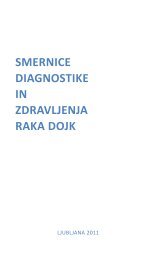Create successful ePaper yourself
Turn your PDF publications into a flip-book with our unique Google optimized e-Paper software.
Angiogenesis independent growth mediated by glioma<br />
stem cells<br />
Per Oyvind Enger, Per Sakariassen, Lars Prestegaarden, Simone Niclou,<br />
Uro{ Raj~evi~, A.J.A Terzis and Rolf Bjerkvig<br />
NorLux Neuro-Oncology, Department of Biomedicine, University of Bergen, Norway and<br />
Centre de Recherche Public - Santé, Luxembourg<br />
A highly infiltrative cancer stem cell phenotype was established by xenotransplantation<br />
of human primary glioblastomas in immuno-deficient nude rats. These tumors<br />
coopted the host vasculature and presented as an aggressive disease without<br />
signs of angiogenesis. The malignant cells expressed neural stem cell markers and<br />
showed a migratory behavior similar to normal human neural stem cells. The cells<br />
showed self-renewal capacity in vitro and gave rise to tumors in vivo. Serial animal<br />
passages, gradually transformed the stem cell tumors into an angiogenesis-dependent<br />
phenotype. This process was characterized by a reduction in stem cells markers.<br />
Pro-invasive genes were up-regulated and angiogenesis signaling genes were<br />
down-regulated in the stem cell tumors. In contrast, pro-invasive genes were downregulated<br />
in the angiogenesis-dependent tumors, derived from the stem cell tumors.<br />
By using gene arrays, proteomics and bioinformatics, we were able to identify two<br />
separate signaling pathways characterized by the two phenotypes. Moreover, based<br />
on our proteomics data, a set of molecular targets towards the cancer stem cells<br />
were identified. In conclusion, we describe a system where primary glioblastomas<br />
can be dissected into two separate malignant phenotypes. One that depends on<br />
angiogenesis and one that is characterized by angiogenesis independent growth.<br />
Our work points at two completely independent mechanisms that drive glioma<br />
progression. The present work underlines the need for developing therapies that<br />
specifically target the cancer stem cell pools in tumors. Examples of such targets will<br />
62l44<br />
be shown.

















